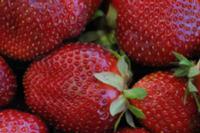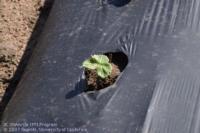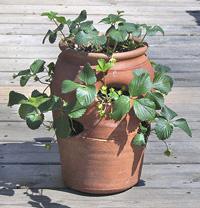Strawberries, growing
-
Strawberries can be planted in the ground or in containers. Plant strawberries in the late winter or early spring. They bear fruit in about 3 months.

Plant June-bearers (short-day) varieties in late summer or early fall for a spring crop. Plant everbearing in spring for a summer crop. If winters are mild, you can also plant everbearing varieites in the fall. Read more about when to plant strawberries.
Plant 8 to 14 inches apart in raised beds at least 5 or 6 inches high and 6 to 12 inches wide, or directly in the ground, spacing the plants 12 to 16 inches apart.
Use rich soil amended with fertilizer and compost. Be sure that the crown of the plant is slightly above grade. Keep soil moist but not soggy.Place a weed block material on top of the soil and plant through small openings in the weed block to keep strawberries off soil and away from slugs and snails, earwigs and sowbugs. Straw can also be used as weed block material. Plants are shallow-rooted; cultivation around plants is not recommended.
PropagatingThe most common way to propagate strawberries is by rooting the runners they produce. You can place the baby plant growing at the tip of the runner in a small pot with soil and wait until it roots before you cut it from the mother plant. If you notice a runner has already rooted near the mother plant, you can cut the runner from the mother plant and transplant the new plant.
To increase fruit production, however, runners should be removed. See more information about trimming or pruning strawberries.
Varieties
There are 2 general classes of strawberries – day neutral or everbearing, and June-bearers or short-day types.
Everbearing types flower and fruit all year long, although the bulk of the fruit is from April through October.
June-bearers produce when day lengths are shorter – fall through early spring.
Popular varieties include:
Everbearing
Albion - good flavor; adapted for California
Quinault - large fruit; good flavor; disease resistant; grows well in California; also adapted to colder climates
Seascape - large fruit; disease resistant; good in California
Selva - fruits in late summer; best in warmer climates
June-bearers
Chandler - good flavor; adapted to southern California
Pajaro - good flavor; large berries; long fruiting season; good in California
Sequoia - good flavor; long fruiting season; disease resistant; good for coastal California, also in other areas
Planting in a strawberry pot
Collect your materials – the pot, well-draining potting soil, slow-release fertilizer, watering pipe.
Mix the fertilizer into the potting soil and moisten before planting.
To ensure the entire pot is watered well, insert a watering pipe into the center of the pot while planting. To create a watering pipe, use a piece of PVC piping about 1½ inches in diameter and 1-2 inches shorter than the pot. The pipe should have a series of 1/8 to 1/4 inch holes spaced around the pipe, about 1½ to 2 inches apart.
Begin planting the strawberry pot by filling the bottom of the pot with soil up to the level of the first planting holes. Next, insert the PVC pipe into the center of the pot and press it into the soil to anchor. Add plants from the bottom up, gently squeezing and shaping the root balls to fit into the holes from the outside in. Ensure the crown of each plant is above the soil level. Water well through the watering pipe. Place into full sun; keep evenly moist. Fertilize again in the summer.



